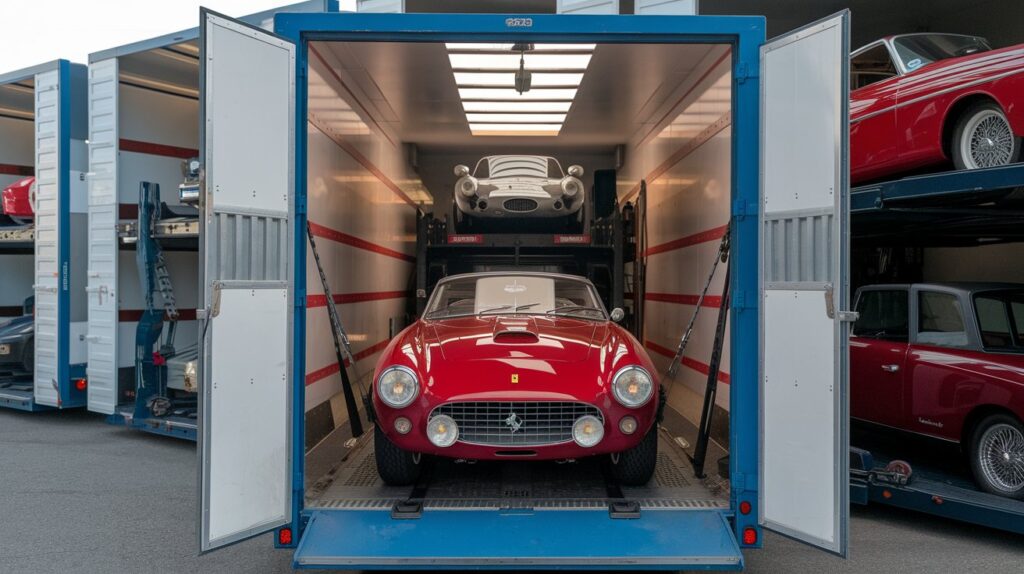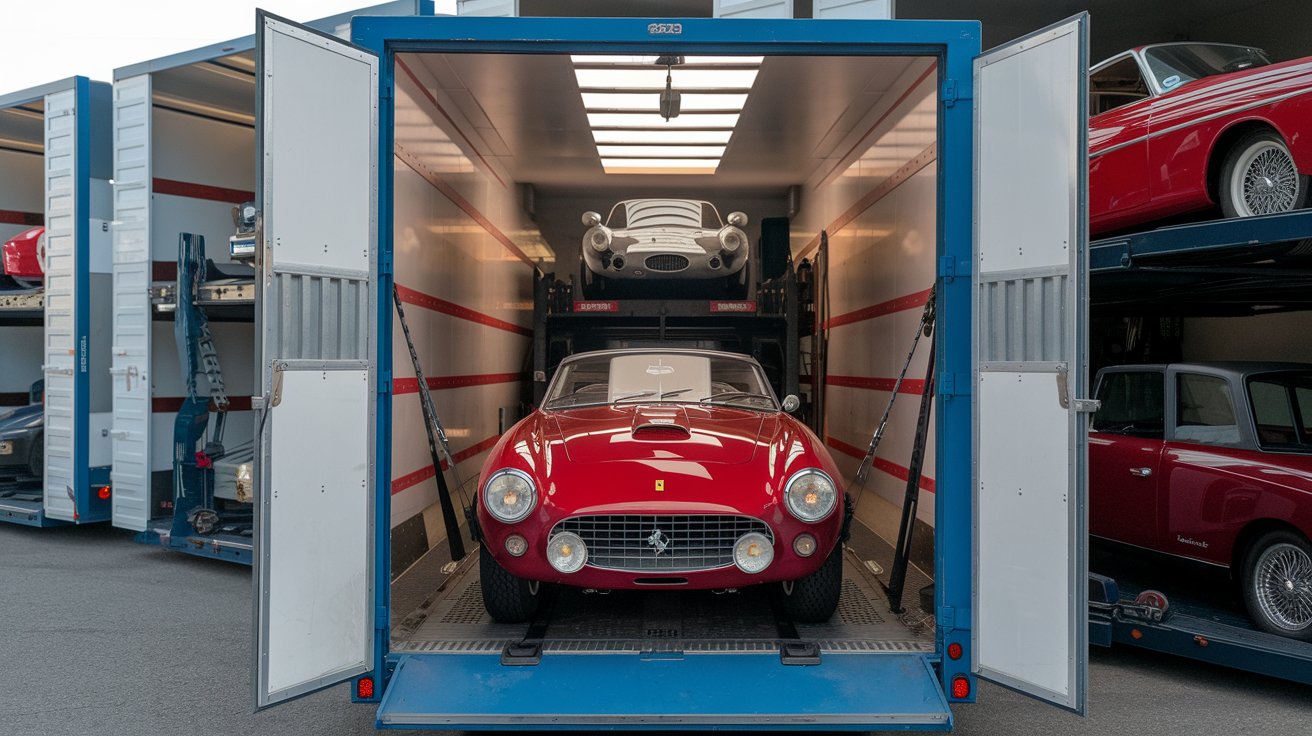Rev your engines and brace up as we start on a fantastic journey through time! The development of automotive transportation from the rattling carriages of the past to the modern, streamlined electric wonders is truly remarkable. Ever wonder how a basic steam-powered vehicle evolved into the modern smart vehicles that speed across our streets? Discover how revolutionary inventions, recognizable models, and cultural changes have influenced not just how we travel but also how we relate to other people as we follow the meandering paths of history. Prepare to learn amazing stories about the vehicles that propel our lives—for knowing where we’ve been can help us navigate an even more thrilling future!

Introduction to the History of Automotive Transportation
Vehicle transportation by companies is an absolutely intriguing adventure. This progress has changed not just how we move but also how we live and engage with the world, from the clattering wheels of horse-drawn carriages to the sleek looks of electric automobiles. Imagine a period when the invention of vehicles was limited to the fantasies of inventors working in their garages. In the modern era, automobile transportation influences cultures and economies all over the world.
We’ll discover major turning points that have shaped the automobile sector as we examine this amazing timeline. Every age had its own inventions and difficulties, reflecting shifts in society. As we take you through the highs and lows of the history of automobile travel, where modern technology meets nostalgia, fasten your seatbelt!
Early Forms of Automotive Transportation
The development of transportation was driven by human ingenuity prior to the scream of motors filling the streets. The voyage started with the simple horse-drawn carriage, which was a sign of grandeur and usefulness. Later, it changed when steam-powered vehicles were developed. This era saw the birth of modern transportation, transforming how people and things moved throughout the country. Let’s examine the turning points that led to the modern automotive wonders.
Horse-Drawn Carriages:
- For centuries, horse-drawn carriages were the cornerstone of transportation. These wooden vehicles, pulled by horses, were essential for both urban and rural travel.
- Beyond their practical purpose, carriages often symbolized wealth and power. The more ornate and luxurious the carriage, the higher the status of its owner.
- However, this mode of transport had its limitations—speed was dictated by the endurance of horses, and travel was often restricted to short distances.
Steam-Powered Vehicles:
- The early 19th century introduced steam-powered vehicles, a groundbreaking innovation that replaced the reliance on animal labor with mechanical might.
- Steam engines used heat to generate energy, propelling these vehicles over longer distances and at higher speeds than horses could manage.
- This leap in technology allowed people to rethink transportation, making it not only faster but also more reliable and scalable for industrial needs.
Industrial and Social Impact:
- The transition from horse-drawn to steam-powered vehicles reshaped industries and society.
- Industries benefited from faster delivery of goods, while communities once isolated by distance found themselves newly connected.
- Roads, once designed for horses, had to evolve to accommodate heavier, faster machinery, giving rise to the first rudimentary infrastructures for automotive transport.
These milestones didn’t just improve automotive transportation—they transformed how societies functioned, fostering growth and connectivity in ways previously unimaginable.
Steam-powered vehicles replaced horse-drawn carriages, but the transition was a social change as much as a technological advancement. By bridging divides between sectors and communities, these inventions set the stage for an era of automotive innovation. Humanity entered an era of speed and connectedness as a result of the subsequent changes that would reshape the fundamentals of logistics and transportation.
The Birth of the Modern Automobile: Henry Ford and the Model T
The early 20th century marked a pivot in automotive transportation with the arrival of the modern automobile. Henry Ford emerged as a pivotal figure, revolutionizing how cars were manufactured and sold. In 1908, Ford introduced the Model T. This vehicle was designed for affordability and reliability, appealing to everyday Americans. Gone were the days when only the wealthy could own a car.
Ford’s innovative assembly line streamlined production processes, drastically reducing costs and time. Each worker became specialized in one task, ensuring efficiency like never before. As more families purchased their first vehicles, roads transformed landscapes across America. The Model T fostered independence and shifted societal norms regarding travel and leisure. This shift not only shaped individual lifestyles but also set off a chain reaction that influenced industries far beyond manufacturing—urban planning began adapting to accommodate growing numbers of cars on roads everywhere.
The Rise of Mass Production and Consumerism in the Automotive Industry
Mass Production Revolution: The early 20th century introduced mass production techniques that transformed the automotive industry, making cars more affordable and accessible to middle-class families.
Henry Ford’s Assembly Line: Henry Ford revolutionized manufacturing with the assembly line in 1913, drastically cutting production time and costs, enabling faster output and affordability.
Consumerism Boom: The reduced cost of cars made them symbols of freedom and status. They quickly became integral to daily life, reshaping how people traveled and connected.
Dealership and Marketing Growth: Dealerships spread across the nation, providing variety and fostering competition among manufacturers. Advertising campaigns targeted new buyers, fueling demand for cars.
Infrastructure Transformation: The surge in car ownership drove the expansion of road networks and reshaped cities, influencing how urban and suburban areas were developed while altering social dynamics.
Innovations in Design and Technology
The automotive landscape has transformed dramatically over the decades. Once dominated by roaring muscle cars, characterized by their powerful engines and aggressive styling, the focus has shifted towards efficiency and sustainability. Muscle cars epitomized raw power. Brands like Ford and Chevrolet crafted vehicles that thrilled enthusiasts with speed and performance. Their designs were bold, appealing to a sense of freedom on open roads.
Today, electric vehicles are reshaping our understanding of car transport. With advancements in battery technology, automakers now offer impressive ranges and quick charging solutions. The sleek lines of modern EVs reflect a commitment to both aesthetics and environmental responsibility. Innovative features such as regenerative braking systems enhance energy efficiency further. Autonomous driving technologies promise to change how we interact with our vehicles entirely. As designers embrace new materials and smart tech integration, the future is undeniably exciting for automotive design.
Impact on Society and Culture
Cars have profoundly reshaped our daily lives. They revolutionized how we commute, allowing for greater distances to be covered in shorter times. The once quaint neighborhoods expanded into sprawling suburbs, where owning a car became essential. The social fabric changed too. Road trips turned family vacations into memorable experiences filled with adventure and exploration. Cars fostered a sense of freedom; suddenly, spontaneous getaways were possible at the drop of a hat.
Culturally, vehicles became symbols of status and identity. From classic muscle cars to sleek electric models, they reflect personal taste and values. Iconic films often portray cars as characters themselves, embodying themes of rebellion or nostalgia. Furthermore, car culture has given rise to communities centered around automotive enthusiasm—car shows and clubs celebrate this passion together. As much as they serve practical purposes, cars are woven deeply into our collective narrative and everyday life experience.
Current State of Automotive Transportation
The automotive industry is undergoing a transformative era, shaped by rapid advancements in technology and growing environmental consciousness. From the rise of electric vehicles to breakthroughs in autonomous driving, these innovations are redefining how we move and interact with transportation systems. However, with progress come challenges, including supply chain complexities and sustainability demands. As the industry adapts to these shifts, it also embraces a future driven by connectivity and smarter solutions, setting the stage for a new chapter in mobility.
- Rise of Electric Vehicles (EVs): Electric vehicles are becoming mainstream as environmental concerns and technological advancements drive demand. Automakers are investing heavily in EV innovation, focusing on improving battery efficiency, expanding charging infrastructure, and reducing costs to make EVs more accessible to the public.
- Autonomous Driving Technology: Self-driving cars are one of the most ambitious trends in the automotive industry, promising increased safety, reduced human error, and enhanced convenience. Despite technological progress, regulatory and ethical challenges remain significant barriers to widespread adoption.
- Emphasis on Sustainability: Consumer demand for greener solutions has pushed manufacturers to adopt sustainable practices, including using eco-friendly materials and improving energy efficiency in production. This trend reflects a broader shift towards reducing the automotive industry’s environmental footprint.
- Challenges in Car Transport Logistics: Global supply chain disruptions and fluctuating fuel prices have added complexity to car transport and distribution. To address these challenges, companies are exploring innovative solutions such as shared mobility services and optimizing supply chain operations.
- Future of Connected Vehicles: Connectivity is set to revolutionize the automotive industry, with smart cars integrating advanced technologies like real-time traffic updates, predictive maintenance, and vehicle-to-vehicle communication. These innovations aim to enhance the driving experience, improve safety, and make transportation more efficient and personalized.
These trends showcase an industry at the crossroads of innovation and challenge, paving the way for a future that prioritizes sustainability, technology, and user-centric solutions.
Conclusion: Reflecting on the Past and Looking Towards the Future
Reflecting on the past reveals a fascinating journey of automotive transportation. From rudimentary horse-drawn carriages to the sophisticated vehicles we see today, each era has contributed significantly to how we move and connect with one another. The transition from steam-powered cars to the birth of modern automobiles marked a pivotal moment in history. Henry Ford’s Model T made car ownership accessible to the masses, transforming society’s relationship with transportation. This shift ignited an era of mass production and consumerism that continues to shape industries worldwide.
As innovations surged forward, so did our desires for speed, power, and efficiency. The evolution from muscle cars roaring down highways to silent electric vehicles underscores not only technological advancement but also changing societal values towards sustainability. Cars have become more than just machines; they symbolize freedom and independence while simultaneously reshaping urban landscapes. They’ve influenced culture—from music and art to social movements—making them integral parts of our lives.
Today, as we navigate trends like autonomous driving and eco-friendly technologies, challenges arise alongside opportunities. Traffic congestion, environmental concerns, and safety issues prompt us all to rethink how we approach car transport in modern society. While it’s important to honor where we’ve been in automotive history, it’s equally crucial to embrace where we’re headed next. As technology continues evolving at breakneck speed, the future promises exciting developments that could redefine personal mobility yet again. Each step forward will carry lessons learned from both triumphs and trials along this remarkable journey through time.


Leave a Reply